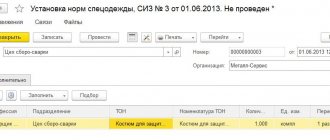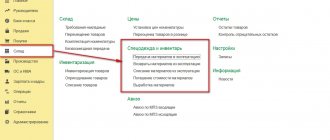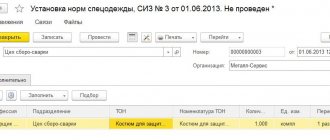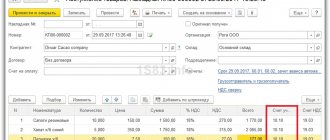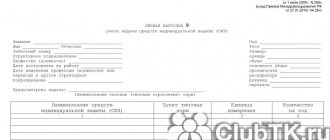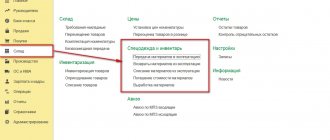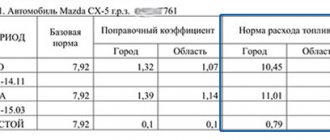All production workers must be provided with protective clothing free of charge. This includes not only a jacket and pants, but also gloves, a helmet, safety glasses, shoes, vests, etc. If the employer does not purchase CO for personnel, workers have the right to independently purchase any appropriate set of workwear, regardless of its price, and the company is obliged to compensate its cost upon presentation of the check.
However, no matter who buys the workwear, it has its own expiration date. The service life of workwear is established by standards, in accordance with the type of production and the work performed by the worker. The same standards establish the deadlines for writing off workwear.
Requirements for CO
When does the period of use of the issued workwear begin?
The shelf life of workwear according to the law depends on the specifics of the activity, climate and work performed. The standards for the period of use of workwear for 2022 are prescribed in the corresponding order of the Ministry of Finance No. 997n. It also indicates how and from what point the service life of CO begins to be calculated, when it needs to be changed, what rules apply to different enterprises, how to determine the wear and tear of clothing and the service life of PPE (personal protective equipment).
So, according to the order of the Ministry of Finance, the time of use of the “special clothing” begins to be recorded from the moment the worker signs in the journal about receiving the CO. This rule applies to the standard form. The accounting for the winter kit, which is often used for 4-5 months a year, depending on the region, includes the time that the CO remains in the warehouse.
Documents establishing the framework for the operation of overalls
Service life of workwear for certain professions
The service life of workwear largely depends on the categories of professions. Work may be performed in outdoor or indoor areas and may involve exposure to hazardous or contaminant substances.
The service life of workwear for working personnel is as follows:
Reinforcement worker's overalls
A canvas suit and hard-toed leather boots can be used throughout the year. Mittens will need to be changed at least once a month.
Norm for issuing workwear for fitters per year
Asphalt worker's overalls
Jackets and overalls made of cotton fabric, leather boots and ankle boots are issued for a year. Shoes with wooden soles are used for up to six months. Combined mittens are used for no more than three months.
Change house for storing workwear
Separate rooms must be equipped for storing workwear. The norms and rules for overalls used in various fields are prescribed in the instructions of the State Sanitary and Epidemiological Supervision
Gas welder's overalls
The period of use of special clothing and standards for operators of resistance welding installations are as follows:
- Suit with fire retardant impregnation - 12 months.
- Boots – 12 months.
- Gloves – 1 month.
How much winter workwear can be used for such a specialty must be looked at according to climate zones.
Workwear set for gas welder
Road worker overalls
To perform all kinds of tasks on the roads, in addition to a waterproof raincoat (36 months), the following protective elements are required with a maximum service life of up to 12 months:
- Cotton suit.
- Leather boots.
- Signal vest.
The useful life of some types of workwear may be limited by actual wear and tear. Such products include canvas knee pads. As for protective gloves or mittens, they must be issued quite often, since they are subject to maximum stress.
Workwear for road workers
Roofer's overalls
The wear life of protective clothing for working on roofs also has its limitations. Regardless of what material the roof is made of, personnel must have PPE used for no more than 12 months:
- Trousers.
- Overalls.
- Jackets.
- Boots.
Felted galoshes can be used for no more than six months, while canvas mittens can be used for no longer than two months. The standards for issuing workwear in 2022 also regulate the procedure for providing employees with appropriate protection.
Comfortable overalls for roofing work
A commission of three or more people checks the quality of purchased workwear and footwear. If during the examination non-compliance with standards is discovered, a corresponding report is drawn up and a complaint is filled out.
Boilermaker's overalls
What period of protective clothing is allowed for certain professions is determined by representatives of the labor protection department, based on the materials used and the design features of the protective devices.
Boiler house workers must be provided with overalls and shoes, replaced with new ones once a year. Canvas mittens are issued every two months. Headphones and earbuds that protect against noise are used until they are physically worn out.
Noise-protective headphones for work in boiler rooms and enterprises with high noise generation
How standards for wearing workwear depend on the type of production
Standards for issuing workwear by profession
The legislative framework provides for the issuance of protective clothing and personal protective equipment to 195 types of professions. In general, the service life of workwear, the standards of which are prescribed in Resolution of the Ministry of Labor No. 997n, depends on three factors - climatic conditions, type of production and work responsibilities of the subordinate. So, for an employee of one workshop where metal is melted, the wearing standards will be different from the norms for an employee of the next workshop where the same metal is processed.
Additional factors:
- type of pollution;
- there is a danger of electric shock;
- temperature indicators;
- presence of toxic substances;
- work associated with increased risk.
How it looks like in an example. Let's say we have a fleet driver and a battery technician. For them, the terms of use of workwear at the enterprise, the table of which is in the above-mentioned resolution, is:
- The driver, who additionally carries out car repairs in the company’s garage, is entitled to the usual cotton overalls, which are issued for up to two years, and gloves, one pair of which is required for 2 months of use;
- For a battery operator, the standards provide for the issuance of a suit with protection from acid burning for 1.5 years and 6 pairs of rubber gloves for 1 year, rubberized boots and an apron with a bib for up to 2 years, gloves made of dielectric material, glasses and galoshes “until worn out.”
An example of standards for the use of personal protective equipment by a repairman
Additional Information! The duration of wearing overalls is additionally established by a special commission during production certification.
Service life of workwear according to standards: GOSTs, standards
The service life of workwear for different professions is prescribed. They take into account a variety of factors, as well as the characteristics of the work.
For convenience, the period of use of workwear - the norms in the table - is presented in the public domain and anyone can familiarize themselves with it. We will give several examples for different positions.
The service life of workwear according to GOST is indicated in the table below. In fact, any item on the list may wear out sooner. Then you should come to the appropriate branch of the enterprise and get a new kit. There is also a possibility of losing an item - in this case, the issue is resolved individually, depending on the charter of the enterprise in particular.
The period for using workwear at an enterprise (the table above) may vary. However, the standards in question are not regulated for all specialties. Ideally, every employee, regardless of who he works, can receive the workwear he needs, taking into account the specifics of his activity. We are talking about professions for which there are no standards for issuing a form, but which are associated with various health risks, for example:
- Constant bright light.
- Noise.
- Various pollutants, including dust.
- Systematic contact with harmful microorganisms that cause various types of pathologies.
- Other actions that may be accompanied by injuries, development of diseases, etc.
Such points should be discussed individually, if necessary, and taken into account when ordering workwear for the entire enterprise.
What is the service life of winter clothes?
If the company operates all year round, then winter workwear, the service life of which is also regulated, is also issued to each employee, if this is required by his activities.
The period of operation of the form for the cold season is influenced by the following factors:
- Features of the climate zone.
- Work intensity.
- Frequency of interaction with various substances, mechanical devices, etc.
- The quality of the materials used.
Winter workwear sets may include: insulated trousers and a jacket, trousers and a jacket with membrane inserts, insulated overalls, insulated boots or boots, gloves or mittens with fur, a warm hat, a short fur coat. The “insulation” of things, in this case, directly depends on the climatic zone in which the work is carried out.
Establishment of the period: “until wear”
As already mentioned, some personal protective equipment is issued to the employee “until worn out.” This list includes a signal vest, the service life of which is unlimited, safety glasses, noise-cancelling headphones, knee and elbow pads, some types of support belts, etc. The issuance of new PPE is provided only in the event of loss, theft, breakage, obsolescence and beyond the operational time frame , installed by the manufacturer.
Sample order for standards for issuing workwear
Thus, for example, if for supporting belts GOST provides for maximum use for a period of up to 25 years, then if during this time it has not become unusable, it is in any case subject to write-off.
In addition, the employer must conduct regular inspections of personal protective equipment. The enterprise must have a log in which each inspection will be recorded.
Additional Information! Typically, for long-life PPE, inspections are carried out every six months or a year.
How to determine for accounting purposes the wear period of workwear if the issuance rate is set “until worn out”
Any wear time can be set for items of equipment, the main thing is that it does not exceed the standards for maximum use of the product by GOST or the manufacturer of the product.
For example, the useful service life of safety glasses can range from a couple of months to 20 years. Therefore, for accounting purposes, it is possible to establish a systematic write-off every year, referring to the conditions of the work performed.
Standards for issuing protective clothing to workers
In Russia, the period of use of work uniforms at enterprises is regulated by the Labor Code (Article 221). The document regulates the employer’s obligation to issue protective uniforms to employees free of charge and in a timely manner if production conditions require it. According to the Labor Code, each employee is entitled to a set of clothing and the necessary personal protective equipment, the choice of which depends on the nature of production and environmental conditions at the workplace.
Each labor sector has its own standards for free provision of work uniforms. They are approved in orders of the Ministry of Labor, as well as the Ministry of Health and Social Development. However, even within the same work activity, these standards may differ, focusing on professional responsibilities and position. For example, auxiliary workers are provided with 12 pairs of gloves per year, and for engineers and foremen, 3 pairs of gloves are issued for the same period.
Depending on climate
Since the operating time of winter and summer clothing may be different, depending on the weather conditions of the region and the seasonal work performed, the time of wearing them should also be different.
Lifespan of winter workwear
The service life of the winter set depends on the climate zone to which the region belongs. That is, there are no uniform standards and those responsible for the service life of work clothes must know their climate zone in order to write off CO on time.
Climate zones were established based on data on average annual temperatures and average wind speed. According to this principle, the territory of the Russian Federation is divided into 4 belts; the manager can find out his belt in the same order of the Ministry of Labor under No. 63. Each belt has its own class of protection, which must be provided by clothing. Class 1 refers to the warmest regions, class 4 to the harshest.
The service life for each class will be as follows
There is also a special climate zone characteristic of the Arctic. There, the winter set should be changed every 1.5 years, and shoes every 2 years.
For how long are summer work clothes issued to workers by law?
There are no fixed service periods for each type of activity. The law says that the service life of summer clothing is 1 year, but the commission must further consider the issue of a possible extension of the period if there are grounds for this.
Not every production facility provides shoes for the summer period. For each industry, the period will be different, depending on the conditions and specialization of the employee. But, according to the norms, shoes cannot be worn for more than three years.
Lifespan of winter workwear
Different terms for the use of clothing are established for employees whose work is associated with special temperature conditions (road workers, security guards). During the cold season, winter overalls are required: a warm jacket, pants or overalls, winter shoes (felt boots or boots). How much winter clothing is issued to security guards, construction workers, and road workers depends on the climate. Categories of climate zones (5 in total) are divided according to average temperature and wind speed in winter.
| Climate zone | Air temperature | Wind speed | Lifespan of winter clothing |
| 1 category | -1°С | 2.7 m/s | Jacket and trousers are issued every 3 years, shoes - every 4 years |
| 2nd category | -9.7°C | 5.6 m/s | Clothes are replaced every 2.5 years, boots - every 3 years |
| 3 category | -18°С | 3.6 m/s | Clothes are replaced after 2 years, shoes - after 2.5 |
| 4th category | -41°С | 1.3 m/s | The jacket and trousers are replaced after 1.5 years, boots - after 2 |
| Special category | -25°С | 6.8 m/s | Replacement is similar to the previous point. Additionally, the employee is provided with a sheepskin coat (4 years), a hat (3 years) and warm mittens (4 years) |
Winter workwear is issued only for the corresponding season. After the winter period, it is handed over for storage to the responsible department of the enterprise, for example, to a warehouse. The employer is responsible for storing seasonal clothing for employees. It is worth considering that specific temperature conditions mean not only the winter period.
Also, when issuing workwear, the microclimate in production is taken into account. At low temperatures there is a need to use warm protective clothing. For example, employees of food industry enterprises that use refrigeration units must be provided with appropriate insulated clothing: jacket, vest, trousers and shoes.
Overalls for line personnel
Depending on the type of production, line personnel include different groups of workers, not only those who work in production. This also includes catering workers, medical organizations, cashiers, salespeople, etc.
Their standards for compliance with workwear are approximately the same. Usually this is a cotton robe or a suit of jacket and trousers.
Additional Information! In winter, line workers who perform job duties outside are required to be given felt boots, a winter jacket or a quilted jacket.
The average service life of overalls for line personnel is limited to 24 months. In some cases this period may be 18 months. If the manufacturer does not indicate an expiration date, the clothing is disposed of after 24 months.
We issue winter workwear
Unfavorable temperature conditions can affect a person’s performance and worsen their health. To protect an employee from the cold, the employer must provide him with personal protective equipment against low temperatures (hereinafter referred to as winter PPE, special clothing). In this case, a number of points must be taken into account.
When should you issue winter clothing?
The main purpose of winter workwear is to provide the worker with protection when in contact with chilled surfaces or to protect them from exposure to low air temperatures. The employee’s obligation to wear it may be determined by the specifics of:
- the work he performs (for example, outdoor work during the cold season);
— workplace (refrigerator, refrigerated (unheated) rooms).
If work is performed, say, in refrigeration units, refrigerated rooms, the employee uses winter workwear, regardless of the conditions “outside the window.”
It’s another matter if the use of winter PPE is due to the onset of cold weather. The procedure for handling such protective clothing is as follows. Workers receive it during the cold season, and with the onset of warm weather, they hand it over to the employer for storage <*>.
However, the legislation does not define what time of year is considered cold for the purpose of providing workers with winter workwear. The period of use is determined by the employer. In this case, he must <*>:
1) take into account local production and climatic conditions. When determining the latter, you can, for example, rely on the definition of the cold period of the year given in the Sanitary Norms and Rules “Requirements for the microclimate of workplaces in industrial and office premises” <*> (hereinafter referred to as SanPiN). Thus, in Belarus this is the period of the year when the average daily outside air temperature does not rise above +10 °C.
In addition to temperature, other factors should be taken into account. For example, humidity, wind speed, time the employee spends outside the premises, the nature of the work he performs (requiring active physical effort or not), etc.;
2) agree on the period of use of winter workwear with primary trade union organizations or authorized persons for labor protection of the organization’s employees. Such a period can be fixed by a local regulatory legal act that establishes the procedure for providing workers with PPE (for example, in the regulation on the issuance of workwear).
An example of the wording of PPE against low temperatures is issued to employees no later than October 1 and is deposited by them until April 15 inclusive.
What to do with winter workwear in summer
What to do with winter workwear during the warm season depends on the specifics of the work and the workplace of the employee using it. If the temperature conditions are unfavorable:
- are absent - winter workwear is handed over to the employer for storage. The latter accepts her according to the name list. This is necessary so that the handed over PPE can be returned to the same employees;
Note: During storage, the employer takes care of winter workwear: dries, cleans from dirt, repairs, disinfects, periodically inspects <*>.
- occur (for example, when working in refrigerators) - winter PPE is also used during the warm period of the year. In this case, there is a peculiarity in determining the timing of their wearing.
As a general rule, the wear period for winter workwear includes storage time in summer <*>. However, if it is used at this time of year, the wear period is reduced.
The employer determines how to adjust the period in each specific case, based on the nature of the work. For example, if an employee is exposed to low temperatures every day, the period of wearing winter workwear can be halved; if the workwear is used a couple of days a work week, it can be reduced by one and a half times.
Extending the wearing period of workwear
Clause 6.17 of the standards for the service life of workwear provides for an extension of the wearing period of PPE. For this purpose, an inventory commission is assembled at the enterprise, which evaluates the further suitability of the overalls.
This practice is quite common. At some enterprises, due to the specifics of the position, workers may not wear special clothing, which needs to be changed every year, for two or three years.
At the same time, in the course of professional suitability for further wearing of clothing, a certificate is issued, which indicates all the defects existing at the time of inspection. If the flaws do not meet the standards for extending the service life of the PPE, it is written off. For example, if the percentage of engine oil stains on a mechanic’s uniform is less than 15, you can wait a while with the write-off.
Today I would like to talk about the timing of wearing workwear in general, and winter clothing in particular.
So, what kind of protective clothing and to whom to issue it is prescribed in the Model State Regulations. There are quite a lot of them, for different industries. If some professions are not included in industry standards, then most likely you will find them (professions) in the “end-to-end” standards (Order of the Ministry of Health and Social Development of the Russian Federation No. 541n dated October 1, 2008).
But the standards for issuing winter workwear are the same for all industries and approved by Resolution of the Ministry of Labor of the Russian Federation No. 70 of December 31, 1997. These standards provide for the following types of winter workwear for workers:
— Jacket with insulating lining;
— Pants with insulating lining;
— Lavsan-viscose jacket with insulating lining;
— Lavsan-viscose trousers with insulating lining;
- Valenki.
The period for wearing winter workwear is set depending on the climate zone: from 4 years in the 1st zone, to 1.5 years in the 4th and special zones.
In a special climate zone, in addition to warm workwear, a sheepskin coat is also issued for 4 years, a hat with earflaps for 3 years, and fur mittens for 2 years.
When constantly working in high mountain areas, warm work clothes and warm safety shoes are issued: at an altitude of 1000 to 2000 meters above sea level for the wearing periods established for regions of the III climatic zone; at an altitude of 2000 m above sea level and above - for the wearing periods established for regions of the IV climatic zone.
The procedure for issuing workwear, both summer and winter, is established by Order of the Ministry of Health and Development No. 290n dated 06/01/2009 and stipulates some features of the issuance of winter workwear and the timing of their wearing:
Clause 21 PPE intended for use in special temperature conditions caused by annual seasonal changes in temperature are issued to employees upon the onset of the corresponding period of the year, and at its end are handed over to the employer for organized storage until the next season.<The time for using these types of PPE is established by the employer with taking into account the opinion of the elected body of the primary trade union organization or other representative body of workers and local climatic conditions.
The time period for wearing PPE used in special temperature conditions includes the time of their organized storage.
This means that having issued winter workwear for 1.5 years (for example, a special climate zone, like mine), for example in October, having received it for storage from an employee in April, you issue it again in October of the next year, that is, the period for wearing winter workwear is 2 seasons.
clause 22 PPE returned by employees after the wear period has expired, but suitable for further use, is used for its intended purpose after taking measures to care for it (washing, cleaning, disinfection, degassing, decontamination, dust removal, neutralization and repair). The suitability of the specified PPE for further use, the need for and the composition of measures to care for it, as well as the percentage of wear of the PPE are established by an official authorized by the employer or the labor protection commission of the organization (if any) and are recorded in the personal record card for the issuance of PPE.
This is for saving purposes. Naturally, this point cannot be abused, and the condition and suitability for reuse of worn workwear must be objectively assessed.
Let me remind you that the standards for issuing workwear in an organization are drawn up taking into account both the Model State Standards and the results of the automated workplace on working conditions.
That's all for today.
Deduction of cost upon dismissal
It is important to understand that work clothes purchased for workers become the personal property of the enterprise, not the worker. Simply put, it is put on balance. Upon dismissal, the employee is obliged to return to the employer the protective clothing on the balance sheet.
Additional Information! If the dismissed employee does not do this, the employer has the right to withhold the market value of the purchased clothing from the calculated salary. But according to the labor code, the employer does not have the right to withhold more than 20% of the employee’s salary.
How to report on the use of work clothes
Typically, the responsibility for keeping track of work clothes is assigned to a responsible employee, for example, a warehouse manager. But, according to the law, the main responsible person, who during the inspection will answer to the commission, is the immediate supervisor of production.
Reporting can be carried out both in written and electronic form, and can be presented either in a journal or in a card index.
PPE accounting scheme
